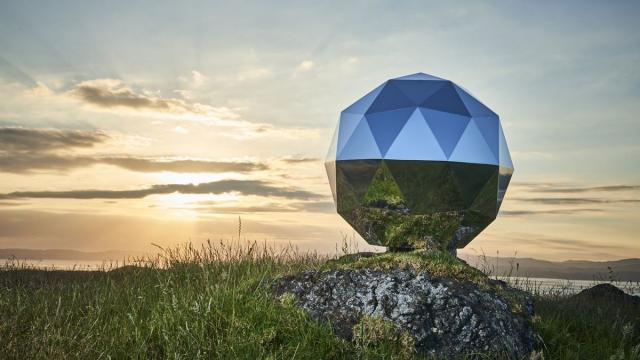Last week, rocket startup Rocket Lab launched a 91cm-wide mirror ball into orbit. Called “Humanity Star”, it’s supposed to remind us that we’re all puny specks of dust living in the terrifying vastness of the Universe. Some astronomers have spoken out about the stunt, claiming the sparkly object will interfere with their work — one even compared the abusiveness of the act to sticking “a big flashing strobe-light on a polar bear”. That’s an overstatement, but the bigger problem is the precedent this otherwise useless satellite creates.
Image: Rocket Lab
As we wrote yesterday, Humanity Star is supposed to give us goosebumps when we look up into the night sky, a “reminder to all on Earth about our fragile place in the Universe”, in the words of Rocket Lab CEO Peter Beck.
But as The Guardian now reports, some astronomers are pissed, saying it’s a stupid indulgence that will only complicate their work:
“Wow. Intentionally bright long-term space graffiti. Thanks a lot @RocketLab,” California Institute of Technology astronomer Mike Brown wrote on Twitter.
Or, as the director of astrobiology at Columbia University Caleb Scharf wrote in Scientific American, the star represented “another invasion of my personal universe, another flashing item asking for eyeballs”.
“Most of us would not think it cute if I stuck a big flashing strobe-light on a polar bear, or emblazoned my company slogan across the perilous upper reaches of Everest,” Scharf wrote. “Jamming a brilliantly glinting sphere into the heavens feels similarly abusive. It’s definitely a reminder of our fragile place in the universe, because it’s infesting the very thing that we urgently need to cherish.”
Harsh words, to be sure. But are they right? We toss satellites into orbit all the time, and this disco ball isn’t going to be much brighter than satellites of the same size. Is Humanity Star really going to make that much of a difference to astronomers?
“I understand the concerns of many astronomers, especially those doing optical work,” Abel Méndez, a planetary astrobiologist and NASA MIRS Fellow at the University of Puerto Rico at Arecibo, told Gizmodo. “There is always a very low probability of a satellite confusing or obscuring an astronomical observation. This is especially true for bright ones such as Humanity Star. Luckily, they move very fast out of the field of view.”
Méndez says he’s not particularly concerned with these sorts of short-lived satellites, so long as they don’t become a trend.
Emily Petroff from the Netherlands Institute for Radio Astronomy says we put satellites into orbit with great frequency, and that most people would be shocked by how much stuff is up there.
“The huge network of satellites that orbit our planet are already a plague on radio astronomy,” she told Gizmodo. “Transmissions from these satellites ruin an increasingly large fraction of our observations every year and make some areas of the sky perpetually inaccessible to our telescopes. It would be tragic for optical astronomy to face the same fate. Humanity Ball is supposedly meant to make us reflect on our place on planet Earth, but it and future satellites like it, could be doing so at the expense of scientific observations trying to understand our place in the Universe.”
“Satellites are already complicating astronomical observations,” Jonathan McDowell, an astrophysicist at the Harvard-Smithsonian Center for Astrophysics and an expert on artificial satellites, told Gizmodo, “and there’s a fair concern that if the proposed mega-constellations get going and there are 10 times or 100 times as many satellites as today, almost every ground based astronomical image could be marred by satellite trails, which makes automated analysis of the image harder — and makes the images useless for some purposes.”
“What is particularly annoying about this satellite is that it is designed to be visually bright and has no other purpose,” McDowell added. “It’s the space equivalent of someone putting a neon advertising billboard right outside your bedroom window.”
Having said that, McDowell thinks Beck is grossly overestimating how bright his satellite will be. What’s more, he says a single satellite in low orbit for only a few months won’t mess up astronomy too badly. “I think the legit concern is more that it’s a bad precedent, if you had a whole bunch of these it would be a real problem.”
John C. Barentine, director of conservation with the International Dark-Sky Association, believes the impact of Humanity Star will be minimal.
“It orbits below the International Space Station — which already produces a very bright trail across the night sky, if humanity needed something to ponder — and will likely fall out of that orbit and back to the Earth within a few weeks,” Barentine told Gizmodo. “The odds that it will produce a glint, seen by a research telescope with a hopelessly small field of view, are exceedingly small.”
A larger concern, says Barentine, is that the stunt may send a message to others with similar plans, like the Orbital Reflector, for example.
“And it makes me think that if these kinds of stunts continue, it’s only a matter of time before enterprising companies launch giant ‘billboards in space’ that further pollute the night sky and present an existential threat to conducting astronomy research from the ground,” said Barentine. “That’s certainly not the kind of world we want to see.”
